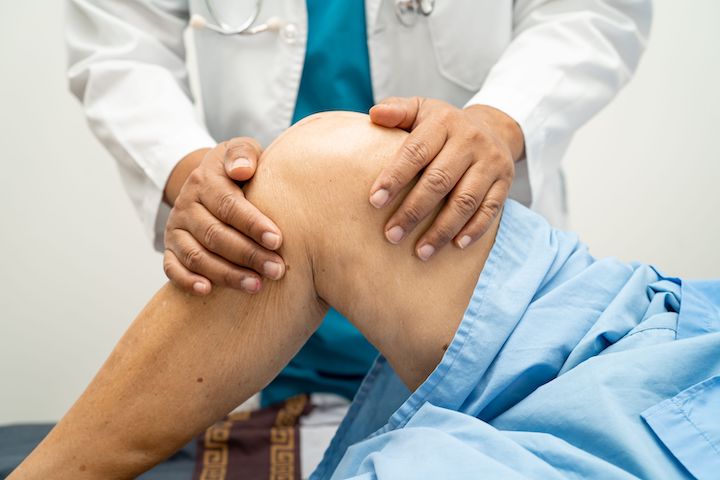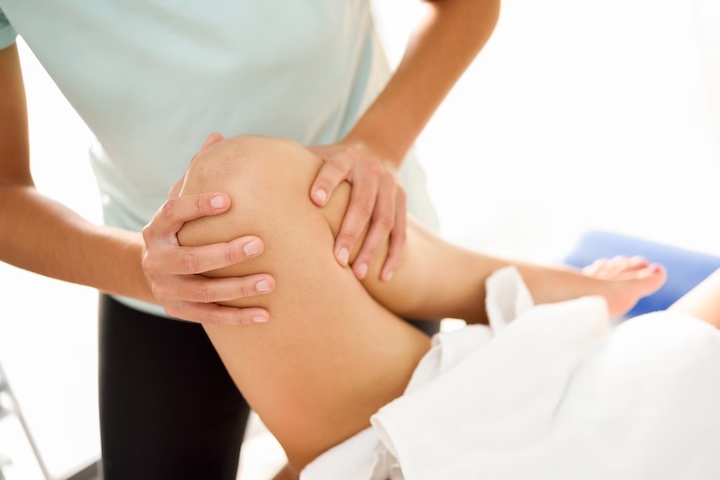Thigh pain is a common condition encountered by individuals across different age groups, occupations and lifestyles. This discomfort may result from various causes, including muscle strains, stress fractures, nerve conditions and certain diseases. Understanding the root cause is crucial as it directly influences the course of treatment and the potential for recovery.
The intricacies of this health concern extend beyond mere physical discomfort, as it can significantly impact one’s quality of life, hindering mobility and daily activities. To manage thigh pain effectively, knowing its symptoms, diagnostic procedures and possible treatments are essential. Thorough knowledge empowers individuals to take proactive steps in their healthcare journey.
This article examines the various dimensions of thigh pain: its common causes; symptoms; diagnostic methods; medical and non-medical treatments; preventive measures; indications for seeking professional help; with insights into recovery and rehabilitation processes. Each section provides valuable information to give readers a comprehensive insight into managing this condition efficiently while maintaining control over their health decisions.
Numerous factors can contribute to the onset of thigh pain, including muscular strains, nerve damage, and certain medical conditions such as arthritis or deep vein thrombosis.
One common cause of thigh pain is due to muscular strains brought about by overuse or injury. This situation often results in thigh muscle pain that may manifest as a dull ache during rest periods and sharp stabbing pains during physical activity.
 Photo Credit: Mego Studio
Photo Credit: Mego Studio
Moreover, nerve damage can also lead to significant discomfort, mainly if it affects the femoral nerve, which controls the muscles that allow for movement and sensation in the hip and thigh region. This condition commonly manifests as nerve pain in the groin and inner thigh.
Additionally, various medical conditions are directly linked with hip and thigh pain. Arthritis, a joint inflammation disease frequently experienced by older adults, can cause severe discomfort within these areas due to its progressive nature affecting joint functionality over time.
Similarly, Deep Vein Thrombosis (DVT), a blood clot condition primarily occurring within deep veins in lower regions such as thighs, can result in intense stabbing pain in the thigh coupled with noticeable swelling.
Henceforth, understanding these common causes of thigh pain proves essential for appropriate identification and subsequent management enabling individuals better control over their health outcomes.
Manifestations of discomfort in the upper leg region may range from a sharp, stabbing sensation to a dull, persistent ache. This discomfort is commonly referred to as thigh pain and its symptoms can present in various forms depending on the underlying cause.
Thigh pain at night could indicate conditions such as restless leg syndrome or peripheral artery disease, whereas sharp pain in the inner thigh might suggest nerve impingement or muscle strain. Furthermore, muscle pain in the inner thigh often signifies overuse or injury due to physical activities like running or cycling.
Other noteworthy manifestations include:
These symptoms can significantly impact daily life and activities by imposing limitations on mobility and overall quality of life. Hence it becomes crucial for individuals experiencing persistent or recurrent episodes of thigh pain to seek professional medical advice promptly for appropriate diagnosis and treatment planning.
Determining the cause of discomfort in the upper leg region entails a comprehensive medical evaluation that includes a thorough patient history, physical examination, and relevant diagnostic tests.

Photo Credit: Sasirin Pamai
The process of diagnosis of thigh pain involves several stages, including initial screening based on symptom descriptions, followed by more detailed examinations to identify specific causes such as injuries or diseases.
For instance, lateral thigh pain differential diagnosis may involve investigating potential causes like iliotibial band syndrome or meralgia paresthetica. Suppose the patient has undergone recent surgical procedures like hip replacement and complains about thigh muscle pain after hip replacement. Further investigations are warranted to rule out complications such as infections or dislocations in that case.
Check out our guide to explaining Meralgia Paresthetica in its entirety.
In some cases where patients present with specific conditions such as inner thigh pain during pregnancy weeks, additional considerations must be made due to physiological changes associated with pregnancy.
This might involve evaluating for potential issues like pelvic girdle pain or round ligament pain while ensuring both mother’s and unborn child’s safety.
It is important to understand that the diagnosis of thigh pain can sometimes be complex due to the wide range of possible underlying causes involving different systems including musculoskeletal, nervous, and vascular among others.
Therefore, an accurate diagnosis requires careful clinical judgement based on synthesising all available clinical data collected through history taking, physical examination and diagnostic tests.
Management strategies for discomfort in the upper leg region are multifaceted, encompassing various modalities such as medications, physical therapy, and in some cases, surgical interventions.
For instance, how to cure thigh muscle pain may involve over-the-counter or prescribed anti-inflammatory drugs and analgesics to alleviate acute symptoms. Concurrently, therapeutic exercises under the guidance of a physiotherapist can enhance flexibility and strength in the affected area, reducing the likelihood of recurrent episodes of thigh and groin pain. In more severe instances where structural abnormalities or significant injuries contribute to pain in thigh and groin areas, surgical procedures may be required.
The specific treatment approach often depends on the underlying cause and individual circumstances. For example, upper thigh hip pain could result from conditions like bursitis or arthritis, requiring targeted therapies such as corticosteroid injections or joint replacement surgery.
On another note, thigh pain during pregnancy is commonly due to increased pressure on nerves from expanding uterus; hence non-pharmacological approaches like maternity support belts or prenatal yoga might prove beneficial.
All management strategies must be discussed with healthcare professionals who take into account both the medical evidence base and the patient’s unique needs for optimal outcomes whilst minimising any potential risks associated with treatment options.
Several strategies can be employed in non-pharmacological interventions for discomfort in the upper leg region, including lifestyle modifications, physiotherapy routines, and assistive devices. These non-medical treatments for thigh pain aim to address the root causes of the discomfort rather than merely alleviating symptoms.

Photo Credit: Javi Indy
For instance, during pregnancy, inner thigh pain is a common complaint due to hormonal changes that lead to ligament laxity and weight gain. To relieve this discomfort, pregnant individuals may find benefit in prenatal yoga or gentle stretching exercises under the guidance of a trained healthcare professional.
Similarly, those experiencing pain after hip replacement surgery may find relief through targeted physical therapy routines that strengthen surrounding muscles and promote joint flexibility.
Adopting different sleeping positions with supportive pillows between legs can help alleviate pressure points and distribute body weight evenly for individuals suffering from pain in the thigh region when lying down on their side. Assistive devices such as walking aids or orthotic shoe inserts may also be recommended depending on the severity of one’s condition.
It is important to note that while these non-medical treatments offer potential solutions for thigh pain relief, consulting with a medical professional is always advisable before embarking on any new treatment regime. This ensures an individualised approach tailored to each person’s unique needs and overall health status, thereby putting patients back in control despite their ailments.
Proactive measures to ward off discomfort in the upper leg region encompass a comprehensive approach, including regular physical activity, weight management, and ergonomics assessment. Regular physical activity strengthens the leg muscles and improves flexibility, reducing upper thigh pain when walking up stairs or inner thigh pain when walking.
Weight management can alleviate undue stress on the joints and muscles of the hip and thighs, potentially mitigating pain in these areas. An ergonomics assessment identifies potential risks related to posture or movement patterns that could lead to discomfort, such as thigh pain after sitting for a long time.
The following preventive strategies are recommended:
Implementing these preventive steps does not guarantee complete avoidance of experiencing thigh pain; however, they do significantly reduce its likelihood. Always heed early warning signs such as minor aches during movement or increased discomfort after certain activities.
Recognising these symptoms early on allows for timely intervention, which preserves mobility while ensuring optimal leg health.
Attending to recurring discomfort in the upper leg region should not be delayed, especially when it interferes with daily activities or if over-the-counter pain relievers fail to provide relief. Certain warning signs may necessitate immediate medical attention, such as thigh pain after hip replacement. This could indicate complications like infection, dislocation or loosening of the prosthesis, which requires prompt evaluation and intervention.
Similarly, experiencing sharp pain in the inner thigh when squatting can indicate a thigh muscle strain or tear that might require physical therapy or even surgical repair.
Other symptoms may warrant a doctor’s visit, even if they initially seem less severe. For instance, burning pain in the upper thigh could signify meralgia paresthetica, a condition caused by compression of the lateral femoral cutaneous nerve responsible for sensation in your outer thigh.
Moreover, persistent upper inner thigh pain when walking could suggest stress fractures minute cracks formed due to repetitive force, often from overuse such as repeatedly jumping up and down or running long distances.
Such instances underline the importance of timely consultation with healthcare professionals who can accurately diagnose and manage these conditions effectively.
Effective management and treatment of discomfort in the thigh region often necessitate a comprehensive recovery and rehabilitation intervention plan. This particularly applies to individuals who experience thigh pain when lying down or posterior thigh pain, as these symptoms can severely impact their quality of life.

Photo Credit: Freepik
The recovery phase typically includes rest, administration of anti-inflammatory drugs, and potential surgical procedures such as hip replacement. It is noteworthy that mid-thigh pain after hip replacement can occur due to various factors, including the body’s reaction to foreign materials, nerve damage during surgery or improper healing. However, with appropriate medical intervention and adherence to prescribed treatments, these problems can be effectively managed.
Moving towards a normalcy post-recovery requires an equally important phase – rehabilitation for thigh pain. Rehabilitation is essential for restoring physical strength and regaining functionality and mobility in the affected area. It may involve physiotherapy sessions to enhance muscle strength around the hips and thighs, improve flexibility, and correct posture and gait abnormalities associated with hip replacements or other underlying conditions causing posterior thigh pain.
Additionally, healthcare professionals might recommend home-based exercises to reinforce progress made during therapy sessions. Significantly though, each individual’s rehabilitation plan will vary depending on their unique circumstances, such as age, overall health status and severity of their condition; thus requiring close monitoring by medical practitioners throughout this process.
Upper thigh pain can result from various conditions, including muscle strains, nerve issues such as sciatica, hip problems, or even deep vein thrombosis. It could also be due to overuse or physical activity.
You should be concerned about thigh pain if it’s severe, persists for more than a few days, is accompanied by swelling, redness, or warmth around the affected area, or if it occurs after an injury. Also, you should seek medical attention if the pain is associated with other symptoms like fever, unexplained weight loss, or if it interferes with your ability to move or walk.
Thigh pain without injury can be due to various reasons, such as nerve impingement, infection, arthritis, or vascular issues. Conditions like meralgia paresthetica can cause thigh pain due to nerve compression. Certain diseases like diabetes can also cause thigh pain due to nerve damage.
Muscle strains, nerve issues, joint problems like arthritis, or circulatory conditions like peripheral artery disease or deep vein thrombosis can cause pain in the legs and thighs. It can also be a symptom of systemic diseases such as diabetes or lupus.
Upper thigh pain can be caused by various conditions, including muscle strains, nerve issues (like sciatica), hip problems, or even certain infections or diseases. Sometimes, it can also be a result of overuse or improper exercise techniques.
While thigh pain is often due to minor issues like muscle strain, it can sometimes indicate a more serious condition, such as a blood clot or hip fracture. If thigh pain is severe, persistent, or accompanied by other concerning symptoms, it’s important to seek medical attention.